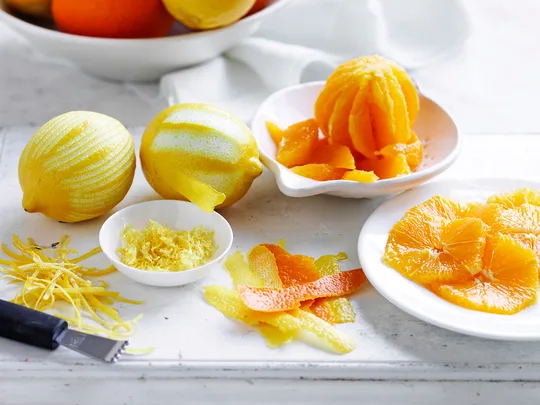It’s no secret that when citrus fruit is in season, our favourite zesty bakes are taken to another level of deliciousness.
Not only are the fruits at their juiciest and cheapest, the peel is at its brightest and can make a wonderful decorative addition to your citrus desserts.
However, the terminology around citrus rind, often called zest, can be confusing. Recipes often call for some variation of grated rind, but what is the difference between citrus rind, shreds and zest?
Here, we set the record straight and share some of the easiest preparation techniques and decorative ideas you can achieve with these versatile citrus fruits.
Finely grated citrus rind
Use a microplane or fine grater to remove the coloured rind only from the fruit; this is where the oils and flavour are.
Avoid the white pith as it is bitter.

Finely grated lemon zest is a must-have for this simple lemon curd recipe.
Citrus zest/shreds
Pull a “zester” (a small tool with several small sharp round holes along the top) lengthways down the citrus fruit to remove the peel in fine strips.
To zest lemons or citrus fruit without a zester, peel the rind from the fruit using a vegetable peeler. Remove any white pith with a small sharp knife. Cut the rind into thin strips.
Citrus rind strips
Peel rind thinly with a vegetable peeler into long strips.
Add rind to milk, cream or other liquids and heat together to infuse the flavour of the rind without adding texture or extra liquid.
Segmenting citrus
To easily segment oranges and other citrus fruit, first cut top and bottom off the fruit.
Following the curve of the fruit, cut away the skin with the white pith.
Holding the fruit over a bowl, cut down either side of each segment, between the membranes, to release the segment.
Slices without rind
Cut and peel the fruit as above, then cut the fruit crossways into slices.
This technique results in stunning slices that are beautiful atop layer cakes and in salads.
This orange, fennel and hazelnut salad recipe, for example, really makes the most of them for a eye-catching addition to any lunch spread.
Candied citrus slices
Candied citrus pieces are a delicate and delicious decoration for cakes and desserts, where slices of citrus fruit are simmered in sugar syrup to soften and sweeten.
To prepare, slice citrus thinly. Add slices to a medium saucepan and cover with water. Bring to a simmer, then drain in a sieve. This is to soften the rind and remove some of the bitterness from the pith.
Combine 1 cup caster sugar and 1 cup fresh water in the same pan. Stir over medium heat, without boiling, until sugar is dissolved. Bring to a gentle simmer.
Reduce heat to low; return citrus slices to pan. Simmer gently for 30 minutes or until most of the slices are translucent. Cool in the syrup or lift from syrup and place on a wire rack or sheet of baking paper in a single layer.
Slices can be kept in an airtight container, with baking paper between layers, in the refrigerator for two months.

Try your hand at candied citrus with this orange pound cake with candied cumquats recipe.
And some handy citrus tips…
Heating whole citrus in the microwave for 10 seconds before squeezing will give you more juice.
On average, a medium lime will give about 1 tablespoon of juice, a lemon about 2 tablespoons and an orange about ¼ cup (3 tablespoons).










